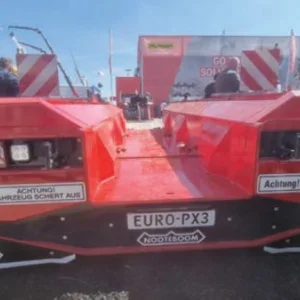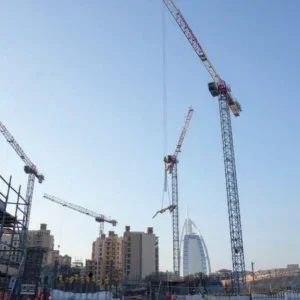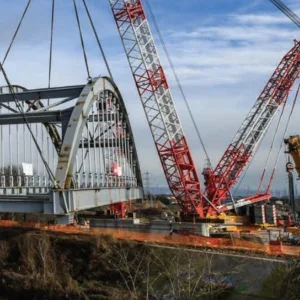It is a source of enormous irritation and frustration to Italian crane manufacturers that there remains a perception among some customers – or more specifically potential customers – that Italian cranes are somehow inferior to those from the north of Europe.
Truck loader crane manufacturer Fassi recently seized the initiative and brought a group of UK truck crane specifiers and purchasers to its various factories around Bergamo in northern Italy.
The party of about 20 potential customers were mainly dealers for major commercial vehicle manufacturers such as Scania, Mercedes, and Iveco. They were clearly impressed – not just by the hospitality but by what they saw inside the factories. One said during the return journey to the UK that he had never bought Italian cranes before, but he would now. Another said that the visit had totally shattered his misconceptions about Italian manufacturers. Very informative and very useful, said a third.
There are several Italian loader crane manufacturers that rely heavily on outsourcing. In contrast, there is not much on the crane that Fassi does not manufacture itself at one or more of its five factories. It has been Fassi’s policy over the years to seek to acquire its suppliers to enhance control over production and quality.
It is a policy that has been successful for Fassi, helping it to market leadership in Italy. The company was founded in 1946 as a truck repair and transport business by Franco Fassi who had previously been in the haulage business. Fassi produced his first crane in 1965 and gradually crane manufacturing took over as the main activity.
Though its world sales are only about half those of market leaders Palfinger and Hiab, Fassi is at the front of a group of Italian companies that are increasingly strong rivals to the northern Europeans.
The largest of Fassi’s factories is Officina Mechanica Fassi (O.ME.FA) in Albino near Bergamo. Here, Fassi produces its medium and heavy duty cranes in an indoor production area of 11,000m2. Down the road at Nembro, a subsidiary called Carmo Srl produces light to medium duty cranes in a 10,000m2 covered area. At nearby Almè, rams and other hydraulic components are produced and castings are machined. These three factories, all in the Bergamo area in the shadow of the Alps, account for the major part of Fassi’s crane production.
A little way to the south lie two more factories. Booms are manufactured in Campagnola, near Reggio Emilia. Near Modena is a factory that produces cranes with longer boom sections, specifically designed for the US wall board market. This factory, acquired in 1987, also produces aerial work platforms for the Italian market only, but this is a poor market these days, with low barriers to entry and even more manufacturers competing than in the crane market.
For Fassi one of the key challenges is recruitment and retention of skilled labour. It is having to move towards automated welding and painting because, it seems, too few are prepared to stick at these arduous jobs for more than a couple of years, in spite of above average rates of pay.
Product testing is a feature of Fassi’s operations. Each new prototype is put through 200,000 full cycles before it is put into production. And every new crane is tested before delivery to customers.
Across all the factories there are approximately 350 employees in the group. Last year Fassi produced about 5,000 cranes and had sales of E80m, according to Giovanni Fassi, the young managing director and son of founder and president Franco Fassi.
Distribution through 40 countries is largely through third party agents, except in Germany and the UK where company-owned subsidiaries lead Fassi’s promotional efforts.
As well as doing the major part of its own manufacturing (electronic components, cables and controls are bought in, as are castings), Fassi also has an engineering design department to rival any in the industry. There are various technical developments in progress. Fassi has just added HBC to its short list of suppliers of remote control systems. It also uses Hetronic’s remote controls, but the preferred supplier is Scanreco of Sweden. Nine out of 10 Fassi cranes with remote controls use Scanreco because its system is designed specifically for knuckle boom cranes, says Giovanni Fassi.
Remote control is becoming increasingly dominant with 60% of all Fassi cranes now being supplied with remote controls, he adds. In Europe the demand for remote controls is even greater; 80% of cranes supplied are fitted with them.
On the product development front, launched at the SAIE exhibition in Bologna in October 2000 was a new range of XS cranes (with XS denoting ‘extra speed’), designed for public works with grab and rotator. Higher operational speeds are achieved by increasing the oil flow. Available XS models are the F60A XS, F80A XS, F95A XS and F110A XS.
Fassi’s use of the XS designation should not be confused with Hiab’s use of the same letters. For Hiab, the XS is a new modular range rather than a grab loader, but Fassi claims that it came up with the name first and does not want to change now.
Next month a fully-electronic load moment limiting device becomes available. Until now, Fassi has used a hydraulic system. The new system has been jointly developed with 3B6 which is producing it exclusively for Fassi.
Claimed benefits of the new LMI include the simplification of component installation because it uses an analogue signal instead of a pressure signal, meaning that the hydraulic valves of the old system are no longer needed. It is also, Fassi claims, easier to set, more reliable and has more functions, such as the ability to store information about the working life of the crane (a similar concept to an aircraft’s black box). The new LMI will be standard on all cranes from the F45A through to the biggest cranes in the range.
A further technical development is a prototype fieldbus system that is now being produced. The target is to have it available and in production by the end of the year. A fieldbus is a serial data transmission system that reduces the need for cables as all data is digitally transmitted, at higher speeds, all on just two cables. Initially the system is being used to transfer data between the LMI and the remote control base unit.
Hiab and Palfinger may have been able to claim technical leadership in the past, but Fassi is showing that the Italian manufacturers are now challenging them hard.






